Doan Doan Tuan
Tran Viet Dung
CPIM
Abstract:
The impact of drought and saltwater intrusion has changed the farming practices of people in the Mekong River Delta (Mekong Delta) in general and the West Coastal region in particular. The impact has turned challenges into opportunities in the region’s agricultural production, shifting agricultural production from inefficient 2-rice farming to highly economical shrimp-rice cultivation. Shrimp cultivated in rice fields use mainly natural food, require low feed costs, sufer less diseases, being high quality, and the ecological environment is protected because rice uses waste products from shrimp farming.
However, the development of the rice-shrimp system is facing challenges, due to the inadequate irrigation facilities to control drought and saltwater intrusion, poor road system to offer conditions for agricultural machines to operate; fragmented, small-scale agricultural production, lack of farmeres cooperation to form a suficient large production area, enterprises purchasing agricultural products difficult to access the State’s suppot are contrains to formation of effective agricultural production linkages
In order to support production, enhance production and product consumption linkages between farmers and farmers, between production households and enterprises, it is necessary to implement the completion of on-farm road system to create conditions for machines to work effectively, to invest in irrigation infrastructure ensuring proactive irrigation and drainage for shrimp-rice production, at the same time encourage farmers to cooperate in production on a large scale, in parallel with the thorough implementation of supportive policies, so that enterprises can access loans, support capital to ensure production linkage.
Keywords: West Coastal region of Mekong Delta, drought and saltwater intrusion, shrimp-rice cultivation, on-farm irrigation and road system, agricultural production and product consumption linkage, supporting policies
- Drought, salinity intrusion, and production conversion
In recent years, due to the impact of climate change, along with the construction of reservoirs and hydropower development in the upper Mekong, drought and saltwater intrusion in the Mekong Delta tend to increase. In the dry season of 2009-2010, the area of winter-spring rice affected by salinity was up to 620,000 ha, accounting for 40% of the total area, concentrated in the provinces of Kien Giang, Soc Trang, Bac Lieu, and Ca Mau. In the dry season of 2013, about 300,000 ha were affected by drought, of which 100,000 ha were directly affected. Especially in 2016, 11 out of 13 provinces in the region announced natural disasters due to drought and saltwater intrusion, including Kien Giang province. affected 182,700 ha of productive land, 194,000 households (900,000 people) (Report of Central Steering Committee on Disaster Prevention, 2016).
Implementing the policy of restructuring the agricultural sector, adapting to climate change, the production transformation in the western coastal area of the Mekong Delta is taking place rapidly. Especially since Resolution 09/2000/ND-CP was issued, allowing the conversion of inefficient land areas (rice production, salt production, coastal wetlands) to aquaculture. One of the trends is converting the area planted with two rice crops to one rice and one shrimp crop. Shrimp-rice farming has a rapid growth rate, in 2000, the area of rice-shrimp farming was 71,000 hectares, in 2014 the total area of rice-shrimp farming more than doubled, reaching 152,977 hectares, accounting for 27.98% of the total area. brackish water shrimp farming in the whole region. The provinces with large shrimp-rice farming areas are Kien Giang (71,500 ha), Ca Mau (43,297 ha), Bac Lieu (28,285 ha), Soc Trang (7,581 ha), and Ben Tre (4,833 ha).
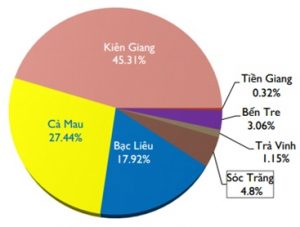
Figure 1. Area of shrimp and rice in Mekong Delta provinces
Although production has made positive changes, the household production scale is small and fragmented, the quality of agricultural products is uneven, the cost is high, there is a lack of linkages between production and consumption, and it is difficult to access. Consumption markets are obstacles to production and farmers’ lives in the region
Based on an investigation and assessment of the current production status of farmers, the linkage of production and product consumption between households, between production households and enterprises, transportation and irrigation infrastructure serving Rice-shrimp production in two typical districts An Bien and An Minh, Kien Giang province rice-shrimp production conversion area in the West Coast, Mekong Delta.
2.Status of rice-shrimp production
2.1.Research area
Kien Giang started farming shrimp in rice fields in 2002, is currently the province with the largest shrimp-rice farming area in the Mekong Delta provinces. The districts of An Bien, An Minh, U Minh Thuong, Hon Dat, and Kien Luong are currently cultivating 2 rice crops but they are not effective due to saline intrusion, so they switch to 1 shrimp crop. , 1 crop of rice
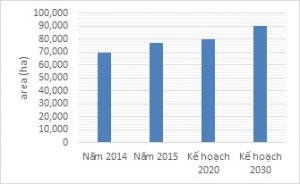
Figure 2. Area of rice-shrimp in Kien Giang province
The study area is located in two districts of An Bien and An Minh, with a natural area of about 99,000 hectares, the shrimp-rice area in 2018 is about 59,200 hectares, is purely agricultural and low-lying areas, most of the production area is new. discovered about 50 years ago. Since then, the authorities and people of Kien Giang province have invested a lot in building a system of irrigation works for production such as digging canals for water drainage, removing alum, embanking dikes to prevent natural disasters. , construction of temporary sluices and dams contributes to stabilizing production and people’s lives. However, in the face of complicated developments of drought and saltwater intrusion, the transport and irrigation infrastructure systems still cannot meet the needs of the people. demand for production conversion to control drought and salinity to serve the production.
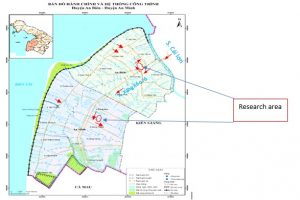
Figure 3. Administrative map and irrigation system of An Bien district, An Minh district
2.2.Irrigation-transport works, field structures for rice-shrimp production
The system of irrigation works in the two districts of An Bien and An Minh is an enclosed network of canals connecting rivers and streams to the sea. Freshwater sources in the region are mainly from the concentrated rainfall in the area and a part is taken from the Hau river and led back through the canals connecting the Hau river with the Cai Lon – Cai Be rivers. In the dry season, the rainfall in the region only accounts for about 5% of the annual rainfall. Therefore, it is not able to supply fresh water and push salinity, so the drought situation here is very serious. Even in the rainy season, despite heavy rainfall, but due to no water retention works, when the rain stops, salt water penetrates the inner canals, resulting in no freshwater for farming. Saltwater intrusion is always serious through the Cai Lon River and the canals connecting to the West Sea. In the dry season, almost the entire area has salinity exceeding 4g/liter.
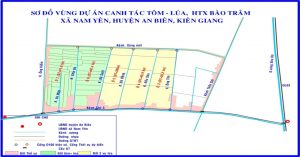
Figure 4. Map of traffic and irrigation system in the field of Bao Tram Cooperative, An Bien district
In the past time, investment in building irrigation systems in the province in general and the two districts of An Bien and An Minh, in particular, has mainly focused on renovating and upgrading the existing primary and secondary canal systems. To minimize the impact of drought and salinity, in recent years, the State has begun to construct a system of sluices to control coastal salinity. The construction and management of the irrigation system, in-field traffic, according to decentralization, falls under the responsibility of the locality (district and commune level) and the beneficiaries.
Previously, the irrigation system, in-field traffic was built mainly for the production of two-crop rice. The transition to the rice-shrimp model requires many changes in the field structure, transportation system, and in-field irrigation. Although the conductor has spent a lot of effort and money to supplement and improve the fields, the current in-field infrastructure system has not yet met the requirements of active production.
Table 1. The channel system and decentralization of management in An Bien and An Minh regions
| Rank | Channel level | Mining management unit |
| 1 | – Channel level I (>5.000ha)
– Channel level II county boundaries – Channel level II inter-district (Example: Xang Xeo Ro Channel) |
Irrigation Sub-Department of Kien Giang Province |
| 2 | – Channel level II inside district
– Channel level III inter- community – Channel level III inside community (100-500ha) (Example: Thu 3 Channel) |
District People’s Committee (District Agriculture Department) |
| 3 | – infield channel (<100ha)
(Example: Xang Moi Channel, Ông Kiem Channel) |
Commune People’s Committee (Cooperative / Cooperative group) |
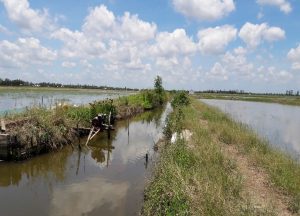
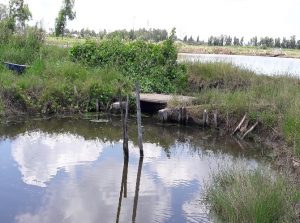
Figure 5. Intra-field irrigation and transportation system in shrimp-rice production areas
2.2. Rice-shrimp production
i) Area size, investment, production cost-profit
On average, each farmer household in the An Bien and An Minh areas has 1-2 fields. The average total area of households in Bao Tram Cooperative, An Bien district is from 2-5ha/household; At Thanh An Cooperative, an average of 1-3ha/household

To make the transition from cultivating 2 rice crops to producing one shrimp crop and one rice crop, people renovate the previous rice fields with an initial cost of about 10-12 million VND/ha (Table 2)
Table 2. The initial cost of converting 2 rice production to rice-shrimp production
| Rank | Content | Cost (million VND) |
| 1 | Making banks, digging ditches (creeks) around the field (for 1ha) | 5-6 |
| 2 | Sewer installation (for 1 plot) | 4 |
| 3 | Treatment of alum, residues of initial pesticides (for 1ha) | 1,4 |
The results of surveying the efficiency of rice shrimp and rice production at Thanh An cooperative, An Minh district and Bao Tram cooperative, An Bien district show that rice-shrimp production brings in a profit of 60-100 million dong. /ha.year, higher than 2 rice transplants, about 40 million VND/ha.year (Table 3)
Table 3. Income-cost statistics of rice-shrimp production and 2 rice crops
| Shrimp-rice (million VND/ha) | 2 rice crops (million VND/ha) | ||||
| Income from rice | 40 | Thu nhập từ tôm | 50-90 | Income from rice | 34,5 |
| Rice cost | 15 | Chi phí tôm | 15 | Rice cost | 14,2 |
| Profit from rice | 25 | Lợi nhuận từ tôm | 35-75 | Profit from rice | 20,3 |
| Profit of the year | 60-100 | Profit of the year | 40,6 | ||
ii) Shrimp farming, rice farming
In the rice-shrimp farming system, after raising a shrimp crop, farmers plant a rice crop. Then, organic waste on the bottom of the pond, after harvesting shrimp, will make the rice fields fertile, rice growers only fertilize a small amount of fertilizer to meet the growing needs of the plants. In contrast, shrimp farming after the rice crop, the pond bottom has been mineralized, so toxic substances are reduced, limiting the aging of the shrimp farming area due to long-term saltwater intrusion, and cutting pathogens in the pond. Stable environment, shrimp farming does not need to use a lot of drugs and chemicals, limiting production costs, increasing profits
In the dry season, saltwater outside rivers and canals is used for shrimp farming, when it rains, freshwater is used to grow rice. Black tiger shrimp is a common stocking subject, from January to August every year, after the end of the rice crop, the pond is renovated, the renovation period is from January to February, and shrimp farming is carried out from From March to August, after harvesting shrimp, farmers carry out salt washing and soil preparation to prepare rice fields, from September to the end of December (Figure 7).
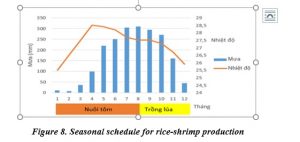
Black tiger shrimp cultured in the rice-shrimp area is adapted to a wide range of salinity, but the most suitable range is from 5-15%o. The suitable pH is 7.5-9. The best pond area is 1-2 ha, the surrounding ditch system covers an area of about 25-30% of the pond area, the surrounding ditches have a width of about 2.5-3 m, a depth of 1-1, 2 m. The fields have a water supply and drainage sewers and nursery ponds, the area of the nursery pond is 10-15% of the pond area.
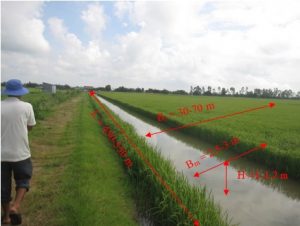
Figure 9. Shrimp-Rice field
Rice is mainly grown with varieties of OM, ST, a red bush… After the shrimp crop is over, farmers cut trenches, put water in the field to wash salt, then harrow and level the field, when the salinity is reached. below 1%o, proceed with sowing or transplanting. The rice on the square base uses fewer chemicals and pesticides, so it has good quality, ensures clean rice, and has a higher economic value than two-crop rice fields.
3. Organization of production and sale of rice-shrimp products
i) Actual situation of linking production and consumption of shrimp-rice products
Along with the shift from two-rice crop farming to the rice-shrimp production model, many cooperative production models in the form of THT (the majority) or cooperatives began to be formed to link production and production. consumption of rice products on a very limited scale. In An Bien and An Minh districts, the area of cooperatives is usually 50-100 hectares, the area of cooperative groups is 10-30 hectares.
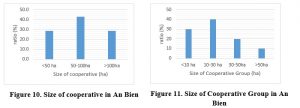
The linkage between agricultural production and consumption between farmers and enterprises in An Bien, An Minh, Kien Giang province in particular, and the Mekong Delta, in general, is still very limited. Rice products in the field of 2 rice crops, mainly collected by traders. Rice products in rice-shrimp fields, rice production almost does not use pesticides, has high quality, is consumed by the market and businesses are interested in clean food, so the consumption of rice has many advantages. profit. However, the association of production and consumption of clean rice products with enterprises is still very limited. According to statistics of the Department of Agriculture and Rural Development, in An Bien district, in 2018, the signing of contracts between cooperatives/THTs with rice-consuming units only reached 570 ha//33,740 ha (accounting for 1.7% of the rice area. district-wide). In An Minh district, the area of enterprises consuming rice products in 2018 reached 972.7 ha/22,823 ha (accounting for 4.3% of the district’s rice area).

Figure 12. Sales channels for rice products in An Bien and An Minh
Because shrimp production is still fragmented, with no production links, small output, and no raw material areas to meet business requirements, 100% of shrimp products are sold through traders

Figure 13. Sales channels for shrimp products in An Bien and An Minh districts
ii) Difficulties in linking production and consumption of shrimp-rice products
+ Due to the lack of works to regulate drought and salinity, the system of canals, water supply, and drainage, the irrigation infrastructure system from the focal point to the field surface has not met the requirements of shrimp – rice production.
+ The intra-field traffic system is often combined with in-field supply and drainage canals with small dimensions, which do not meet the conditions for bringing in rice-harvesting machines, leading to people having to use manual cutting at higher costs. compared with machine cutting. Moreover, rice-consuming enterprises also do not accept hand-cut rice because the rice is flooded when harvested, and the quality is not guaranteed.
+ The number of agricultural enterprises currently accounts for a very small proportion, about more than 1%, of the total number of enterprises in the country. In addition, more than 95% of small and medium-sized agricultural enterprises are facing great challenges in improving their competitiveness and developing production linkages along the agricultural product chain; The level of application of science and technology of agricultural enterprises is still low, and the ability to access loans from the State is also limited because investment in agriculture faces many risks.
+ The rice-shrimp production model is mainly household-scale, fragmented and small-scale. Although the locality has had many solutions and policies to promote production linkages between farmer households by building cooperatives and cooperative groups to link production and consumption of rice and shrimp products, the model is small, averaging 30-100 hectares, not meeting the requirements of the raw material area, so it is difficult to link consumption with businesses.
4. Solutions to promote linkages in product production and consumption
i) Completing the system of irrigation works
- The rice-shrimp production area has a system of canals and canals that are closely interconnected due to the lack of works to regulate water sources, control drought, and salinity, and provide information on water quality. weather events. Completing the system of water regulation works on the coastal and riverside focal points, grade 1, 2 canals and inland canals in parallel with installing a water quality monitoring and monitoring system is the preferred irrigation solution. a current pioneer in the rice-shrimp production area
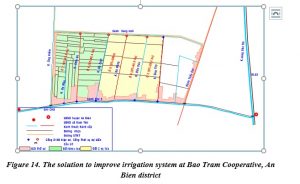
Support to invest in the power system to convert small oil pumps to electric pumps to reduce production costs, estimated at 40% of the cost compared to oil pumps, and at the same time is a solution to promote the linkage of production households.
ii ) Completing the road system in the field, ensuring the operation of agricultural machines
Intra-field traffic in the area is mainly water and road traffic, which is not small and narrow, about 2.5-3m, rough, convex, and not suitable for agricultural machinery to operate. Therefore, it is necessary to expand the size of the inland road according to the standard, the minimum width of the embankment is 3.5 m, for the coastal area, the width of the road surface is at least 6.5 m to ensure the operation of agricultural machinery. effective action
iii) Mechanisms and policies for businesses to access unsecured loans
In the rice-shrimp linkage chain, businesses play an important role, determining the success of the chain. However, at present, manufacturing enterprises, as well as banks, are afraid to invest in this field because of the great risks due to dependence on the market, weather, large production costs, affecting the competitiveness of products. Products.
In recent years, our country’s agricultural development mechanisms and policies have been continuously supplemented and perfected, to create favorable conditions for attracting investment and developing the agricultural economy. The policies focus on incentives for land use, lease, business premises, tax incentives, credit support, labor training, market development, infrastructure investment, and priorities. supporting several investment projects in agriculture especially projects on linkage, deep processing, and application of science and technology. However, there are still many barriers in terms of procedures, funding sources, which have not been met and are not enough to encourage businesses. Therefore, the State needs to boldly create conditions for businesses to access financial support, implement the production process set out by enterprises, supply materials and fertilizers, and support farmers in peace. production center
iv) Support farmers to expand cross-linking large enough to ensure raw material areas for businesses to consume products
The current agricultural production of the rice-shrimp-rice area is mainly on a household scale, small and scattered, production is spontaneous, strong enough for everyone to do, has not yet created a concentrated production area, the product line is large enough, stable. While to be able to compete in the market economy, it is necessary to have high-quality, high-volume products, on-time delivery, and competitive prices, which is something individual farmers cannot do but need to be involved. form a large enough collective (cooperative group, cooperative) associated with enterprises to organize the production and consumption of products.
The current scale of cooperatives in the rice-shrimp production area is about 50-100 hectares, the area of the cooperative group is 10-30 hectares. With this scale, for rice consumption and harvesting, it is easy for businesses to pay for cooperatives and cooperative groups. However, the shrimp harvest is divided into several batches, an average of 9-10 harvests, each harvest lasts 4-5 days, the average yield is about 50-60kg/ha. A refrigerated container of 24-30 tons needs at least 500-600 hectares of ponds with the same sowing and harvesting schedule. Therefore, cooperatives/THTs that want to link businesses to consume shrimp products need to expand the service area and admit more cooperative/THT members. One of the current solutions, as mentioned above, is to support power lines, convert small oil pumps to centralized electric pumps, and encourage farmers to participate in production linkages.
The current agricultural production of the rice-shrimp-rice area is mainly on a household scale, small and scattered, production is spontaneous, strong enough for everyone to do, has not yet created a concentrated production area, the product line is large enough, stable. While to be able to compete in the market economy, it is necessary to have high-quality, high-volume products, on-time delivery, and competitive prices, which is something individual farmers cannot do but need to be involved. form a large enough collective (cooperative group, cooperative) associated with enterprises to organize the production and consumption of products.
The current scale of cooperatives in the rice-shrimp production area is about 50-100 hectares, the area of the cooperative group is 10-30 hectares. With this scale, for rice consumption and harvesting, it is easy for businesses to pay for cooperatives and cooperative groups. However, the shrimp harvest is divided into several batches, an average of 9-10 harvests, each harvest lasts 4-5 days, the average yield is about 50-60kg/ha. A refrigerated container of 24-30 tons needs at least 500-600 hectares of ponds with the same sowing and harvesting schedule. Therefore, cooperatives/THTs that want to link businesses to consume shrimp products need to expand the service area and admit more cooperative/THT members. One of the current solutions, as mentioned above, is to support power lines, convert small oil pumps to centralized electric pumps, and encourage farmers to participate in production linkages.
5. Conclusion
Under the impact of drought and saltwater intrusion, the conversion of two-rice crop production to the rice-shrimp model in the western coastal area of the Mekong Delta is taking place rapidly. However, with the small in-field traffic infrastructure system, which is not yet guaranteed to operate agricultural machinery, the irrigation system is not closed, lacks works to regulate drought and salinity control, and its scale Small-scale, fragmented household production, lack of linkages in production and consumption, and difficulty in accessing consumer markets are all obstacles to production and farmers’ lives in the region.
To support production, strengthen linkages in production and consumption of products between farmers and farmers, and between production households and enterprises, it is necessary to implement the improvement of the in-field transport system to create favorable conditions for machinery and equipment. active agriculture, investment in irrigation infrastructure to ensure proactive water supply and drainage for rice-shrimp production, and at the same time encourage farmers to associate production on a large scale, in parallel with thoroughly implementing support policies support production linkages so that businesses can access loans and support capital, implement the production process set out by enterprises, supply materials and fertilizers, and support farmers to feel secure in production.
References
- Report on review and adjustment of agricultural and rural planning in association with agricultural restructuring in Kien Giang province up to 2020 and orientation to 2030
- Summary report on agriculture and rural development in 2018 An Bien district and An Minh district
- Department of Cooperative Economy, 2016, Guidelines for establishing farmer linkages in the value chain
- Le Xuan Sinh et al., 2011, Analysis of the value chain of black tiger shrimp in the Mekong Delta
- Nguyen Phu Son, 2013, The linkage model “4 houses in rice production and consumption in Dinh Hoa commune, Go Quao district, Kien Giang province
- To Pham Thi Ha Van and Truong Hoang Minh, 2014, Analysis of the ecological black tiger shrimp value chain in Ca Mau province
- Asian Development and Management Institute, 2016, Report on the current status of rice-shrimp development in the Mekong Delta
Translator: Nguyen Duy Tien


